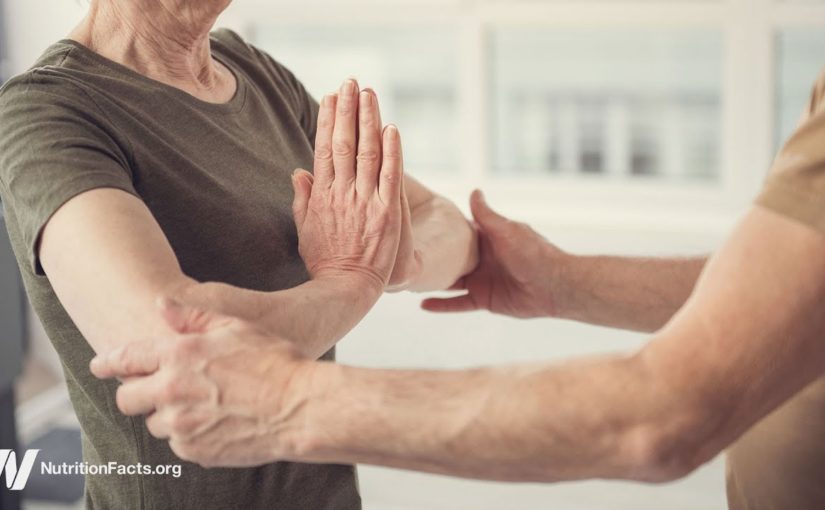“Yoga Put to the Test for Headaches,
Diabetes, Osteoarthritis, and the Elderly” Yoga is an ancient mind-body
discipline which originated in India thousands of years ago, and that’s where most yoga
studies are done to this day. This has raised concerns
that national pride might incline Indian researchers
to quietly shelve any negative results and just publish studies
showing yoga works. This fear is not without precedent. For example, research conducted in
China, Japan, Hong Kong, and Taiwan were found to be uniformly
favorable to acupuncture; all trials, without exception,
were positive. Now, one possible explanation
for this finding is that acupuncture is just
more effective in countries where it is traditionally practiced,
but it’s a little suspicious. So, are Indian yoga trials
more likely to be positive than those from other countries? They looked at hundreds of
Randomized controlled trials of yoga, both done in India and
done in other countries, and trials on yoga conducted in India
had about twenty-five times the odds of reaching positive conclusions
as those conducted elsewhere. Again, yes, yoga might be more
effective in India than elsewhere, but it is a little suspicious. So, for example, if you’re interested
in whether yoga is helpful for treating headaches,
and you read that yoga appears to be helpful
For those suffering from tension-type headaches,
but then you find out that nearly all such studies were
conducted in India, what do you do
with that information? Also, notably, none
of the control groups had any sort of exercise component,
though this may be less critical for tension headaches, since
neither aerobic exercise training… Nor does strength training
appear to help them. So, if we’re to believe
the Indian study conclusions, yoga may indeed help
with tension headaches, but even they found
no effect for migraines. What may help migraines,
though, are other types of exercise, specifically aerobic exercise,
decreasing migraine pain intensity, frequency, and duration,
at least in the short term. What about the benefits
of yoga practice compared to physical exercise
in the management of type 2 diabetes? A significant reduction
in both short-term and longer-term blood sugar control
was noted in the yoga groups compared to other
exercise control groups.

However, the findings may need
to be interpreted with caution, since nearly half of the studies
didn’t define and adhere to a well-planned exercise regimen
in the control group. Furthermore, an exercise intervention
comparable in intensity to yoga was followed only in three
out of the eight studies included. And, for what it’s worth,
The majority of the studies, six out of eight, were from India. When yoga was carefully
compared to sham yoga, which consisted of chair exercises,
standing exercises, and slow walking to match
the yoga session, the relative yoga
benefits evaporated. Both yoga and sham yoga had identical effects
on blood sugar status. Hence, further well-controlled
Randomized trials are required prior to drawing conclusions
about the benefits of yoga in comparison to physical exercise
in patients with diabetes. Similar tentative conclusions were
reached for yoga for osteoarthritis. Put all the studies together
and yoga may indeed be effective for improving pain, function,
and stiffness in individuals with osteoarthritis of the knee,
compared not only to doing nothing but compared
to other kinds of exercise. They had some issues with
the quality of some of the studies, and so only a weak recommendation
for the use of yoga for osteoarthritis, but hey, if you like yoga or if yoga
is the only kind of exercise you’re willing to do, then
It’s probably better than nothing. Finally, in this video,
Let’s look at the effects of yoga compared to active and inactive
controls meaning like compared to other exercise regimens
or just like doing nothing on physical function and
health-related quality of life in adults aged 60 and older. Compared to doing nothing,
They found clear evidence that yoga improves physical function
and psychological well-being in older adults, so it definitely
better than nothing. What about compared
to other exercises? Yoga pulled ahead for lower limb
strength and lower body flexibility, but for improving balance,
mobility, and walking speed, yoga appeared comparable. Psychologically, yoga appeared
to beat out other exercises for alleviating depression
in older adults, but not anxiety or perceived
mental health in general.
As found on YouTubeNatural Synergy $47.⁰⁰ New Non-Invasive Alternative. To Electro-Acupuncture, Producing Astounding Results… Self-Application Is Easy, Rapid Response. You’re about to discover how both chronic and acute pain, skin conditions, migraines, and hundreds of ailments all stem from the same root cause ꆛ Yin Yang
Ailments🗯 such as➯➱ ➫ ➪➬ Chronic pain⇝Low immunity⇝Chronic acid reflux⇝High blood pressure⇝Addictions⇝Fibromyalgia⇝Allergies⇝Osteoarthritis⇝Headaches⇝Low back⇝pain Asthma⇝Headaches⇝Depression and anxiety⇝Urinary problems… to name just a few…







 However, the findings may need
to be interpreted with caution, since nearly half of the studies
didn’t define and adhere to a well-planned exercise regimen
in the control group. Furthermore, an exercise intervention
comparable in intensity to yoga was followed only in three
out of the eight studies included. And, for what it’s worth,
The majority of the studies, six out of eight, were from India. When yoga was carefully
compared to sham yoga, which consisted of chair exercises,
standing exercises, and slow walking to match
the yoga session, the relative yoga
benefits evaporated. Both yoga and sham yoga had identical effects
on blood sugar status. Hence, further well-controlled
Randomized trials are required prior to drawing conclusions
about the benefits of yoga in comparison to physical exercise
in patients with diabetes. Similar tentative conclusions were
reached for yoga for osteoarthritis. Put all the studies together
and yoga may indeed be effective for improving pain, function,
and stiffness in individuals with osteoarthritis of the knee,
compared not only to doing nothing but compared
to other kinds of exercise. They had some issues with
the quality of some of the studies, and so only a weak recommendation
for the use of yoga for osteoarthritis, but hey, if you like yoga or if yoga
is the only kind of exercise you’re willing to do, then
It’s probably better than nothing. Finally, in this video,
Let’s look at the effects of yoga compared to active and inactive
controls meaning like compared to other exercise regimens
or just like doing nothing on physical function and
health-related quality of life in adults aged 60 and older. Compared to doing nothing,
They found clear evidence that yoga improves physical function
and psychological well-being in older adults, so it definitely
better than nothing. What about compared
to other exercises? Yoga pulled ahead for lower limb
strength and lower body flexibility, but for improving balance,
mobility, and walking speed, yoga appeared comparable. Psychologically, yoga appeared
to beat out other exercises for alleviating depression
in older adults, but not anxiety or perceived
mental health in general.
However, the findings may need
to be interpreted with caution, since nearly half of the studies
didn’t define and adhere to a well-planned exercise regimen
in the control group. Furthermore, an exercise intervention
comparable in intensity to yoga was followed only in three
out of the eight studies included. And, for what it’s worth,
The majority of the studies, six out of eight, were from India. When yoga was carefully
compared to sham yoga, which consisted of chair exercises,
standing exercises, and slow walking to match
the yoga session, the relative yoga
benefits evaporated. Both yoga and sham yoga had identical effects
on blood sugar status. Hence, further well-controlled
Randomized trials are required prior to drawing conclusions
about the benefits of yoga in comparison to physical exercise
in patients with diabetes. Similar tentative conclusions were
reached for yoga for osteoarthritis. Put all the studies together
and yoga may indeed be effective for improving pain, function,
and stiffness in individuals with osteoarthritis of the knee,
compared not only to doing nothing but compared
to other kinds of exercise. They had some issues with
the quality of some of the studies, and so only a weak recommendation
for the use of yoga for osteoarthritis, but hey, if you like yoga or if yoga
is the only kind of exercise you’re willing to do, then
It’s probably better than nothing. Finally, in this video,
Let’s look at the effects of yoga compared to active and inactive
controls meaning like compared to other exercise regimens
or just like doing nothing on physical function and
health-related quality of life in adults aged 60 and older. Compared to doing nothing,
They found clear evidence that yoga improves physical function
and psychological well-being in older adults, so it definitely
better than nothing. What about compared
to other exercises? Yoga pulled ahead for lower limb
strength and lower body flexibility, but for improving balance,
mobility, and walking speed, yoga appeared comparable. Psychologically, yoga appeared
to beat out other exercises for alleviating depression
in older adults, but not anxiety or perceived
mental health in general.


 So maybe we should be advertising
the happiness gains, but first, we need to
make sure they’re real. We’ve been talking about associations.
Yes, a healthy diet may reduce the risk of future depression or anxiety, but
being diagnosed with depression or anxiety today could also lead
to lower fruit and vegetable intake. Now, in these studies, you can
indeed show that the increase in fruit and vegetable consumption came
first, and not the other way around, but as the great enlightenment
philosopher pointed out, just because the cock
crows before the dawn doesn’t mean the cock
caused the sun to rise. To prove cause-and-effect you need to put it to the test
with an interventional study. Unfortunately, to date, many
studies were like this, where those randomized to eat fruit
showed significant improvements in anxiety and depression, fatigue,
and emotional distress. Wow, amazing! But that was compared
to chocolate and potato chips. Apples, clementines, and bananas
making people feel better than assorted potato chips and chunky chocolate
wafers—not exactly a revelation. This is the kind of study I’ve been
waiting for: a randomized controlled trial in which young adults were
randomized to a diet-as-usual group, encouraged to eat
more fruits and veggies or a third group was given two servings
of fruits and vegetables a day to eat over and above
their regular diet. And the ones given fruits and
veggies showed improvements in their psychological well-being
with increases in vitality, flourishing, and motivation within just two weeks! However, simply educating people
to eat their fruits and vegetables may not be enough
to reap the full rewards, so perhaps greater emphasis needs to
be placed on actually providing people with fresh produce, for example, offering
free fruit for people when they shop. I know that would certainly
make me happy!
So maybe we should be advertising
the happiness gains, but first, we need to
make sure they’re real. We’ve been talking about associations.
Yes, a healthy diet may reduce the risk of future depression or anxiety, but
being diagnosed with depression or anxiety today could also lead
to lower fruit and vegetable intake. Now, in these studies, you can
indeed show that the increase in fruit and vegetable consumption came
first, and not the other way around, but as the great enlightenment
philosopher pointed out, just because the cock
crows before the dawn doesn’t mean the cock
caused the sun to rise. To prove cause-and-effect you need to put it to the test
with an interventional study. Unfortunately, to date, many
studies were like this, where those randomized to eat fruit
showed significant improvements in anxiety and depression, fatigue,
and emotional distress. Wow, amazing! But that was compared
to chocolate and potato chips. Apples, clementines, and bananas
making people feel better than assorted potato chips and chunky chocolate
wafers—not exactly a revelation. This is the kind of study I’ve been
waiting for: a randomized controlled trial in which young adults were
randomized to a diet-as-usual group, encouraged to eat
more fruits and veggies or a third group was given two servings
of fruits and vegetables a day to eat over and above
their regular diet. And the ones given fruits and
veggies showed improvements in their psychological well-being
with increases in vitality, flourishing, and motivation within just two weeks! However, simply educating people
to eat their fruits and vegetables may not be enough
to reap the full rewards, so perhaps greater emphasis needs to
be placed on actually providing people with fresh produce, for example, offering
free fruit for people when they shop. I know that would certainly
make me happy!